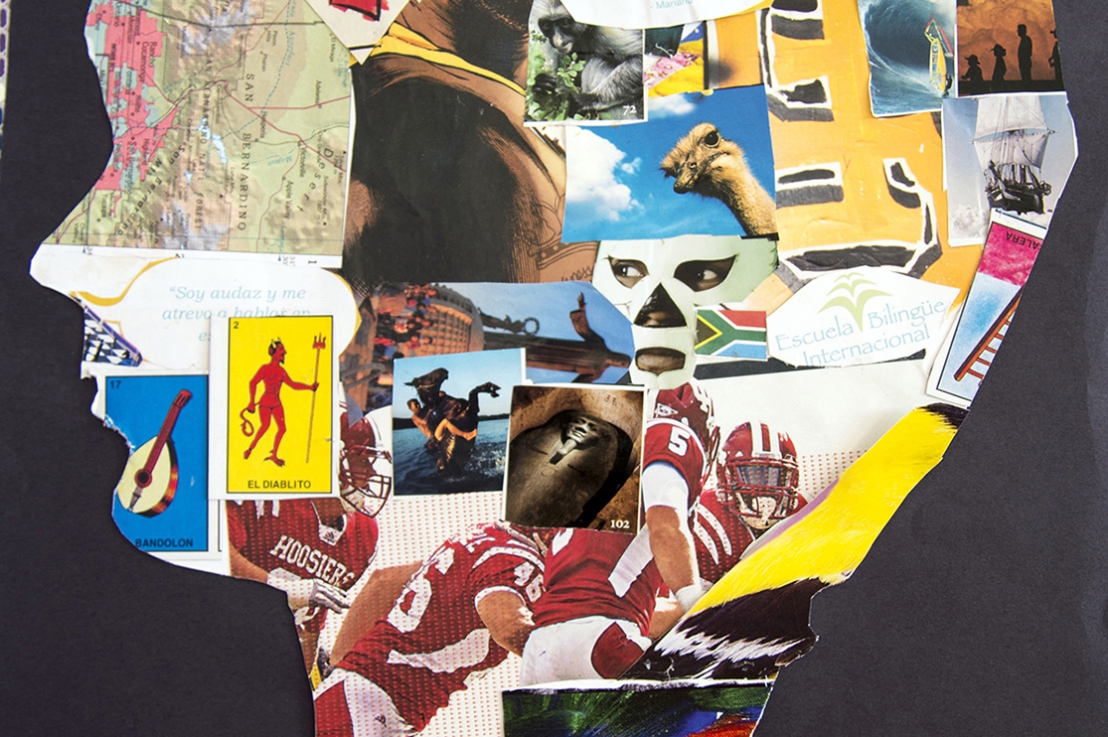Description of the Unit –
Students will explore the concept of symbolism in art, and how they can use symbols—images—to represent aspects of themselves. Using magazines, books and other random two-dimensional found objects (such as playing cards or ticket stubs), students will carefully arrange symbolic imagery into a collage within a silhouette of their own profile.

Activity statement –
If images and symbols from the everyday world could be used to represent who you are, what images and symbols would you choose? Students will explore this idea, in the process discussing the ways in which we sometimes consciously and unconsciously choose to align ourselves with certain images and symbols through the clothes we wear, the way we might decorate our rooms, how we select products to consume, etc.
To introduce students to the idea of symbolic art I usually show them the following three works of art from well-known symbolic artists:



I don’t try to lead them towards any particular analysis or conclusion. I just ask for their reactions and opinions, asking them to notice what they see in each painting. From there, I simply ask them what they think certain things mean. For example, all students will notice the eye on the balloon in Redon’s painting, so I will ask them to express what they think it means. Of course, each student will have his/her unique response, and it’s vital that students understand that symbolism is subjective and relative, that each person will have a unique interpretation of what an image will mean. I will often contrast the fluidity of artistic symbolism with the exactness of universal symbols, such as a red light, an arrow, a question mark, and so forth. By second grade, students will develop an understanding of this difference, and come to appreciate the open interpretation of symbols in art. As they get older and we explore symbolism in later grades, they learn to relish coming to their own ideas or conclusions of what different images could mean. Throughout these years we add socio- and historical contexts to consider, an artist’s personal life, mythology and folk tales, and many other influences so that their interpretation of a symbol becomes more refined. However, for now in second grade, the most important understanding here is the use of imagery in art to express some kind of hidden meaning.
For the project I will also show students examples of other past students’ silhouette collages, namely those of my seventh-grade students who will revisit the project now that they have become adolescents. You can see those here: https://anitasagastegui.com/2020/04/12/7th-grade-silhouette-collage/.
We will discuss why they think the students chose the images they did. Students will be given magazines, books, and other materials to carefully look through and choose that in some way represent or resonate them. They will consider size and placement of these images in order to create a compelling composition within a real-life silhouette of their profiles, making sure to leave no empty spaces between images. Meanwhile the silhouettes themselves are created by having a student stand near a wall while I shine a lamp or flashlight at them (lights in the room can be turned off to help) so that their shadow appears on the wall. A second student traces the silhouette on paper. In this way students get to contribute to one another’s’ artwork. They will share and discuss their choices with the rest of the class.
Goals –
Students should…
Understand:
- The concept of symbolism: how images are used to express a kind of hidden meaning
- Ways in which to use imagery to communicate aspects of one’s self
- How the arrangement of the images affects composition and focal point
Know:
- The terms: symbolism, composition, focal point
Be able to:
- Articulate their choices to their peers
Objectives –
Students will:
- Create a collage with images of personal importance
- Make deliberate choices about the arrangement of these images within the collage
- Describe their choices and process to their peers
Resources and materials –
- Exemplars of previous silhouette collages demonstrating strong and weak compositions
- As many, and varied sources for collage material including books and magazines for students to select images and text from
- White Bristol paper, about 14 x 26
- Black Bristol paper, also about 14 x 26
- Scissors
- Glue sticks
- A lamp that can be used to project a student’s silhouette (as a shadow) onto a blank wall that a classmate can then trace onto the white Bristol paper
- Tape to affix the white paper to a wall while a classmate traces one’s silhouette
Questions –
- What is a symbol?
- What does it mean for one thing to symbolize another?
- What kinds of images would you choose to represent you? Why?
- What is the focal point of your collage?
- How will you arrange the remaining images around the focal point?
- Tell us about the choices you made in selecting these images.
- Tell us about why you decided to arrange these images this way.
Evaluation –
Did students:
- Understand how to choose appropriate symbols to represent themselves?
- Did students use their understanding of composition and focal point to create a compelling arrangement of images?
- Did students clearly articulate their choices?
Informal:
- Group discussions
- Oral and written responses to essential questions
- Peer collaboration





One thought on “2nd Grade – Symbolism through a personal collage”